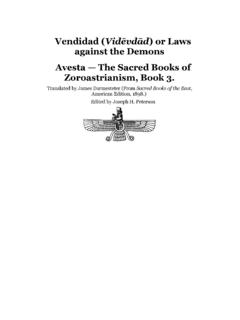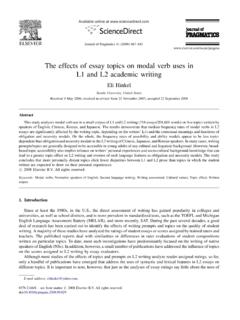Transcription of AVESTA
1 1. teach yourself . AVESTA . A beginner s guide to the SCRIPT, GRAMMAR & LANGUAGE. of the Zoroastrian scriptural texts By Ramiyar Parvez Karanjia June 2011. 2. TABLE OF CONTENTS. Contents 4. I. THE AVESTAN ALPHABET .. 5. 1. The Avestan characters (1) .. 7. 2. The Alphabets (2) .. 8. 3. The Alphabets (3) .. 9. 4. The Alphabets (4) .. 11. 5. Phonetic divisions of the Alphabets .. 13. 6. Orthographic rules for placement of letters .. 15. II. 16. 1. Vowel 16. 2. Consonantal Sandhi .. 19. III. ROOTS & THEIR GRADATIONS .. 21. 1. Roots .. 21. 2. Vowel Gradation (Guna and Vriddhi) .. 22. IV. NOUNS .. 24. 1. Primary and Secondary Nouns .. 24. V. ADJECTIVES .. 25. Degrees of Adjectives .. 26. VI. GENDERS .. 27. VII. DECLENSIONS .. 28. 1. General Case 29. 2. Vowel Bases .. 30. 1. Bases ending in a- Masculine .. 30. 2. Bases ending in a- Neuter .. 31. 3. Bases ending in A- 31.
2 4. Bases ending in A- Feminine .. 32. 5. Bases ending in i- Masculine .. 34. 6. Bases ending in i- 34. 7. Bases ending in i- Neuter .. 34. 8. Bases ending in u- Masculine .. 35. 9. Bases ending in u- Feminine .. 35. 10. Bases ending in u- Neuter .. 36. 3. Consonantal Bases .. 37. 1. Bases ending in T(Na)- 37. 2. Bases ending in T(At)- Feminine .. 38. 3. Bases ending in T(aw)- Neuter .. 38. 4. Bases ending in n- Masculine .. 39. 5. Bases ending in n- Feminine .. 39. 6. Bases ending in n(am)- Neuter .. 40. 3. 7. Bases ending in r- Masculine .. 40. 8. Bases ending in r(at)-Masculine .. 41. 9. Bases ending in h(MaB)- Masculine .. 41. 10. Bases ending in h(Ma)- Neuter .. 42. VIII. PRONOUNS .. 43. IX. NUMERALS .. 46. X. 48. 1. Ten Classes of Conjugation .. 48. 2. Conjugational Tenses and Moods .. 51. 1. Present Tense .. 51. 2. Imperfect Tense .. 53. 3. Imperative Mood.
3 54. 4. Potential 55. 3. Non-conjugational Tenses and Moods .. 57. 1. Future Tense .. 57. 2. Perfect Tense .. 58. 3. Aorist Tense .. 58. 4. Precative or Benedictive Mood .. 59. XII. PARTICIPLES .. 61. 1. Present Participle .. 61. 2. Future 61. 3. Perfect Participle .. 62. 4. Past Participle .. 62. XIII. DERIVATIVE VERBS .. 63. 1. Frequentative or Intensive verb .. 63. 2. Desiderative Verb .. 64. 3. Denominative or Nominal Verb .. 64. 4. Causal Verb .. 64. 5. Incohative Verb .. 65. XIV. PARTICLES .. 66. 1. Adverbs .. 66. 2. 66. 3. Conjunctions .. 67. 4. Prefixes .. 67. XV. SOME GRAMMATICAL 68. 1. Reduplication .. 68. 2. Compounds .. 69. 3. Insertion of redundant letters .. 70. 4. Strong and Weak bases .. 70. 5. Infinitive verbs .. 71. 6. Gerund or Verbal Nouns .. 71. XVI. TRANSLATION .. 72. 1. Syntax - Formation of Sentences .. 72. 1. Translate from AVESTA to English.
4 73. 3. Translate from English to AVESTA .. 74. 4. Specimen Translation of a text SROSH B J .. 75. QUESTION BANK .. 85. KEY TO EXERCISES .. 88. 4. Introduction AVESTA , originally a language of the ancient Indo-Iranian stock of languages, is presently the language of the Zoroastrian scriptures. It is no more used for day to day communication purposes, and hence is referred to as a dead language.. This elementary book, helps beginners to study the Avestan script, learn the language and understand its basic texts. It is prepared in the format of teach yourself books, with the view that a student may learn the language without much help from a tutor. Each chapter is prepared as a separate unit. Most footnotes provide alternative words or contemporary versions of grammatical terminologies. They are intended for reference and are not essential to learning the language.
5 Exercises have been provided at the end of each chapter along with keys to most exercises at the end of the book. A Question Bank has been provided at the end for those who want to evaluate themselves. The book is based on the AVESTA grammar notes given by late Dasturji Dr. Hormazdyar Kayoji Mirza to his students. The style, content and layout of this book is a result of the teaching experience and interaction during the past several years. Considering the elementary nature of the book, grammatical rules have been simplified. Wherever there are multiple options in terminations, only the most frequently used alternative has been given in the book. This book may also be used as a sourcebook for teaching Avestan script and grammar. To study Avestan grammar in greater detail one may refer to A Practical Grammar of the AVESTA language by Kavasji Edalji Kanga (Bombay, 1891), An AVESTA Grammar in comparison with Sanskrit by Jackson (Stuttgart, 1892), Avestan Language III.
6 The Grammar of Avestan by Karl Hoffmann (Encyclopaedia Iranica III, ) and An Introduction to Young Avestan by P. O. Skjaervo (Online, 2003). I hope this book will enable people to get familiar with the Avestan script, grammar and language. Ramiyar Parvez Karanjia Dadar, Mumbai. June 2011. 5. I. THE AVESTAN ALPHABET. The Avestan language AVESTA is the oldest extant Iranian language. It belongs to the Indo-Iranian family of languages. It is the mother of other Iranian languages like Old Persian, Middle Persian, Kurdish, Pashtu and Ossetic. AVESTA heads the Iranian branch of Indo-Iranian language, just as Vedic Sanskrit is the source for the Indian branch, which has languages like Hindustani, Bengali and Marathi. The striking similarity between Vedic Sanskrit and Avestan is on account of their common origin. The Iranian language family can be understood as follows: Language Period Hypothetical proto-Aryan language (now lost) Proto-Aryan period AVESTA Peshdad-Kayan period Old Persian Achaemenian Inscription Pahlavi Ashkanian & early Sasanian Pahlavi (Middle Persian), Manichaenian, Tokharish etc.
7 Sasanian Neo-Persian Post-Sasnian Other important languages in the Indo-European family are Armenian, Baltic . Lithuanian, Latvian, Old Prussian, Anatolian Hittite, Celtic Hittite, Gallic, Hispanic, Irish, Scot, Welsh, Tocharian, Hellenic Classical Greek Modern Greek, Germanic . Old Saxon Modern German, Norwegian, Icelandic, Italic and Latin. Account of the Avestan texts Avestan texts were composed in absolute prehistory when the art of reading and writing had not yet been adequately developed. They were handed down by oral tradition from generation to generation since very ancient times. The Iranian historical traditions regarding the transmission of the Avestan texts are recorded in the D nkard, on the basis of which a succinct account of their transmission, can be formulated. According to this tradition, one written copy of the entire Avestan texts, comprising of 21.
8 Nasks (Volumes), was deposited in the royal archives of King Vishtasp. 21 priestly families were entrusted the task of memorizing one Nask each and the Nasks were orally transmitted from generation to generation. During the Achaemenian times, the written Avestan texts in the royal archives was destroyed during Alexander s invasion and conquest of Iran in 330 Emperor Vologeses/Valkhash I (51 77 ) of the Parthian/Arshkanian dynasty (250 BC-226 AC) made an unsuccessful attempt to regather the 21 Avestan Nasks. The Sasanian Emperor Artakhshir P pak n (226-241 ) instructed his Head Priest Dastur Tansar (Tosar) to compile a standard edition of the 21 Nasks from the scattered Avestan texts. This work was completed under Dastur Adarbad Marespand during the reign of Emperor Shapur II (309-379 ). The Avestan texts were endangered once again when the Arabs invaded and conquered Iran in 641 A.
9 C. However, they were not completely destroyed. Out of 21 Avestan Nasks, 20 were in existence till the 9th century. A summary of 19 Nasks, based on their Pahlavi 6. translations, is found in the VIII and IX books of the D nkard. After the 9th century, most of the Avestan Nasks and their Pahlavi translations have been lost, mainly due to the large scale massacre and destruction brought about in Iran by the Huns Changiz Khan and Halagu Khan in the 14th century and later by the Tartar Timur The Lame in the 15th century. The Extant Avestan texts The extant Avestan texts may be divided as follows: 1. The Yasna (including the Gathas). 2. The Visparad 3. The Vid vd d /Vendidad 4. The Khordeh AVESTA (including the Yashts). 5. Fragments of some of the lost Origin of the Avestan script Though Avestan is the oldest known Iranian language, and it even pre-dates the times of prophet Zarathushtra, it had no script of it own and was orally transmitted from generation to generation.
10 There is a tradition that a copy of the Avestan texts were committed to writing and deposited in the royal archives during the Kayanian and Achaemenian times. However, the script used in writing is not known. They may have been written in primitive indigenous scripts of those times, used for inscribing royal records and edicts. According to literary and archaeological references, attempts were made to commit Avestan to writing during the Parthian period, in the script of those times. However, this attempt was not successful. The Avestan script, as it is used today, was developed in the Sasanian period during the reign of Shapur II, and modified till the times of Cosroe II/. Khushru Purviz (590-628 ). This script, known as the D n Dabireh the script for religious (purposes) , is the script with which we write the Avestan language today. Indian and Iranian Styles There is a slight variance in the way some of the letters of the Avestan script were written by scribes in Iran and India.






